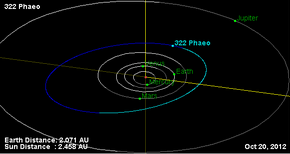 Orbital diagram Orbital diagram | |
| Discovery | |
|---|---|
| Discovered by | A. Borrelly |
| Discovery site | Marseille Obs. |
| Discovery date | 27 November 1891 |
| Designations | |
| MPC designation | (322) Phaeo |
| Pronunciation | /ˈfiːoʊ/ |
| Named after | Φαιώ Phaiō (Greek mythology) |
| Minor planet category | main-belt · (middle) Phaeo |
| Adjectives | Phaeoian /fiːˈoʊ.iən/ |
| Orbital characteristics | |
| Epoch 23 March 2018 (JD 2458200.5) | |
| Uncertainty parameter 0 | |
| Observation arc | 126.48 yr (46,198 d) |
| Aphelion | 3.4656 AU |
| Perihelion | 2.0960 AU |
| Semi-major axis | 2.7808 AU |
| Eccentricity | 0.2463 |
| Orbital period (sidereal) | 4.64 yr (1,694 d) |
| Mean anomaly | 110.49° |
| Mean motion | 0° 12 45 / day |
| Inclination | 8.0544° |
| Longitude of ascending node | 252.36° |
| Argument of perihelion | 115.00° |
| Physical characteristics | |
| Mean diameter | 69.855±0.320 km 71.88 ± 4.32 km |
| Mass | (1.86 ± 0.04) × 10 kg |
| Mean density | 9.56 ± 1.73 g/cm |
| Synodic rotation period | 17.5845±0.0001 h |
| Geometric albedo | 0.089±0.014 |
| Spectral type | Tholen = X SMASS = X B–V = 0.719 U–B = 0.230 |
| Absolute magnitude (H) | 9.01 |
322 Phaeo is an asteroid from the central regions of the asteroid belt, approximately 70 kilometers (43 miles) in diameter. It was discovered on 27 November 1891, by French astronomer Alphonse Borrelly at the Marseille Observatory in southern France. The presumably metallic X-type asteroid is the principal body of the Phaeo family and has a rotation period of 17.6 hours. It was named for the Greek mythological figure Phaeo, one of the Hyades or nymphs. Several other asteroids were named for other of the Hyades – 106 Dione, 158 Koronis, 217 Eudora, and 308 Polyxo.
References
- ^ "322 Phaeo". Minor Planet Center. Retrieved 12 July 2018.
- As in "phæochrome". Oxford English Dictionary (Online ed.). Oxford University Press. (Subscription or participating institution membership required.)
- Schmadel, Lutz D. (2007). "(322) Phaeo". Dictionary of Minor Planet Names. Springer Berlin Heidelberg. p. 42. doi:10.1007/978-3-540-29925-7_323. ISBN 978-3-540-00238-3.
- ^ "JPL Small-Body Database Browser: 322 Phaeo" (2018-05-25 last obs.). Jet Propulsion Laboratory. Retrieved 12 July 2018.
- "Asteroid 322 Phaeo". Small Bodies Data Ferret. Retrieved 12 July 2018.
- Nesvorný, D.; Broz, M.; Carruba, V. (December 2014). "Identification and Dynamical Properties of Asteroid Families". Asteroids IV. pp. 297–321. arXiv:1502.01628. Bibcode:2015aste.book..297N. doi:10.2458/azu_uapress_9780816532131-ch016. ISBN 9780816532131.
- ^ Masiero, Joseph R.; Grav, T.; Mainzer, A. K.; Nugent, C. R.; Bauer, J. M.; Stevenson, R.; et al. (August 2014). "Main-belt Asteroids with WISE/NEOWISE: Near-infrared Albedos". The Astrophysical Journal. 791 (2): 11. arXiv:1406.6645. Bibcode:2014ApJ...791..121M. doi:10.1088/0004-637X/791/2/121.
- ^ Carry, B. (December 2012), "Density of asteroids", Planetary and Space Science, 73 (1): 98–118, arXiv:1203.4336, Bibcode:2012P&SS...73...98C, doi:10.1016/j.pss.2012.03.009 See Table 1.
- "LCDB Data for (322) Phaeo". Asteroid Lightcurve Database (LCDB). Retrieved 12 July 2018.
- Lutz D. Schmadel, Dictionary of Minor Planet Names, p. 42. Springer, ISBN 3-540-00238-3.
External links
- Asteroid Lightcurve Database (LCDB), query form (info Archived 16 December 2017 at the Wayback Machine)
- Dictionary of Minor Planet Names, Google books
- Discovery Circumstances: Numbered Minor Planets (1)-(5000) – Minor Planet Center
- 322 Phaeo at AstDyS-2, Asteroids—Dynamic Site
- 322 Phaeo at the JPL Small-Body Database

| Minor planets navigator | |
|---|---|
| Small Solar System bodies | |||||||
|---|---|---|---|---|---|---|---|
| Minor planets |
| ||||||
| Comets | |||||||
| Other | |||||||
This article about an asteroid native to the asteroid belt is a stub. You can help Misplaced Pages by expanding it. |